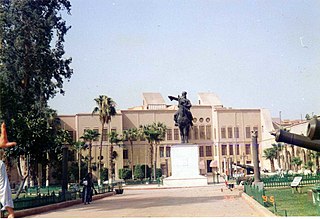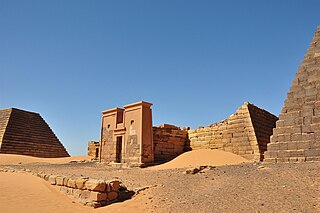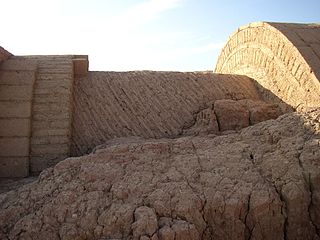 W
WAblaq is an architectural technique involving alternating or fluctuating rows of light and dark stone. Records trace the beginnings of this type of masonry technique to the southern parts of Syria. It is associated as an Arabic term, especially as related to Arabic Islamic architectural decoration. The first recorded use of the term ablaq pertained to repairs of the Great Mosque of Damascus in 1109, but the technique itself was used much earlier.
 W
WThe Bibliotheca Alexandrina is a major library and cultural center on the shore of the Mediterranean Sea in the Egyptian city of Alexandria. It is both a commemoration of the Library of Alexandria that was lost in antiquity, and an attempt to rekindle something of the brilliance that this earlier center of study and erudition represented. The idea of reviving the old library dates back to 1974, when a committee set up by Alexandria University selected a plot of land for its new library. Construction work began in 1995 and, after some US$220 million had been spent, the complex was officially inaugurated on 16 October 2002. In 2010, the library received a donation of 500,000 books from the Bibliothèque nationale de France (BnF). The gift makes the Bibliotheca Alexandrina the sixth-largest Francophone library in the world.
 W
WThe City of the Dead, or Cairo Necropolis, also referred to as the Qarafa, is a series of vast Islamic-era necropolises and cemeteries in Cairo, Egypt. They extend to the north and to the south of the Cairo Citadel, below the Mokattam Hills and outside the historic city walls, covering an area roughly 4 miles long. They are included in the UNESCO World Heritage Site of "Historic Cairo".
 W
WThe funerary complex of Sultan al-Ashraf Qaytbay is an architectural complex built by Sultan al-Ashraf Qaytbay in Cairo's Northern Cemetery, completed in 1474. It is often considered one of the most beautiful and accomplished monuments of late Egyptian Mamluk architecture, and is pictured on the Egyptian one pound note.
 W
WCoptic architecture is the architecture of the Coptic Christians, who form the majority of Christians in Egypt.
 W
WThe Egyptian National Military Museum is the official museum of the Egyptian Army.
 W
WEl Gouna is an Egyptian tourist resort, owned by Samih Sawiris and developed by Orascom Hotels and Development, dating from 1989. It is located on the Red Sea in the Red Sea Governorate of Egypt, 20 kilometres north of Hurghada. It is part of the Red Sea Riviera, and a host city of the El Gouna Film Festival.
 W
WHassan Fathy was a noted Egyptian architect who pioneered appropriate technology for building in Egypt, especially by working to reestablish the use of adobe and traditional mud construction as opposed to western building designs, material configurations, and lay-outs. Fathy was recognized with the Aga Khan Chairman's Award for Architecture in 1980. In 2017, Google celebrated Fathy with a Google Doodle for "pioneering new methods [in architecture], respecting tradition [Egyptian heritage and tradition], and valuing all walks of life".
 W
WThe Fatimid architecture that developed in the Fatimid Caliphate (909–1167 CE) of North Africa combined elements of eastern and western architecture, drawing on Abbasid architecture, Byzantine, Ancient Egyptian, Coptic architecture and North African traditions; it bridged early Islamic styles and the medieval architecture of the Mamluks of Egypt, introducing many innovations.
 W
WThe Heliopolis Palace is one of the three Egyptian presidential palaces and residences, the others being Montaza Palace and Ras el-Tin Palace, for the executive office of the President of Egypt. It is located in the suburb of Heliopolis, northeast of central Cairo and east of the Nile in Egypt. It was originally built as the grand Heliopolis Palace Hotel in 1910. Now it is for the use of the President of Egypt.
 W
WHeliopolis style is an early 20th-century architectural style developed in the new suburb of Heliopolis in eastern Cairo, Egypt. The Belgian Cairo Electric Railways and Heliopolis Oases Company, responsible for planning and developing the new suburb, created the new style to implement an exclusive distinctiveness to the design of its buildings. This revivalist style is a synthesis of Medieval Egyptian Revival, Moorish Revival, Persian Revival, and European Neoclassical architecture styles.
 W
WThe Khanqah and Mausoleum of Sultan Barsbay or Complex of Sultan Barsbay is an Islamic funerary complex built by Sultan al-Ashraf Barsbay in 1432 CE in the historic Northern Cemetery of Cairo, Egypt. In addition to its overall layout and decoration, it is notable for the first stone domes in Cairo to be carved with geometric star patterns.
 W
WMamluk architecture was a flowering of Islamic art during the reign of the Mamluk Sultanate (1250–1517), which is most visible in medieval Cairo and is hugely inspired by the former Fatmid and Byzantine architecture of Egypt. Religious zeal made them generous patrons of architecture and art. Trade and agriculture flourished under Mamluk rule, and Cairo, the caliphate's capital, continued to be one of the wealthiest cities in the Near East and the center of artistic and intellectual activity. And as described in the words of Ibn Khaldun, "Cairo is the center of the universe and the garden of the world", with majestic domes, courtyards, and soaring minarets spread across the city.
 W
WThe Mausoleum of Tarabay al-Sharifi is a late Mamluk funerary complex in Cairo comprising the tomb of amir Tarabay al-Sharifi as well as a sabil and kuttab, built in 1503–1504. It is located in the Bab al-Wazir Cemetery on the edge of the Darb al-Ahmar district of historic Cairo. An adjacent gate gives access from this district to the rest of the cemetery. It is considered a good example of late Mamluk architecture, combining artistic and ornamental sophistication with practical functionality in the arrangement of its different elements.
 W
WThe Mosque of Ibn Tulun is located in Cairo, Egypt. It is the oldest mosque in Egypt as well as the whole of Africa surviving in its full original form, and is the largest mosque in Cairo in terms of land area. Since Ibn Tulun Mosque has much open space, it boasts both sunlight and shadows. It is built around an open square courtyard which allows natural light to travel through. Ibn Tulun Mosque features Samarra style - its decorations being created from carved stucco and wood. This mosque is a popular tourist attraction.
 W
WA nilometer was a structure for measuring the Nile River's clarity and water level during the annual flood season. There were three main types of nilometers, calibrated in Egyptian cubits: (1) a vertical column, (2) a corridor stairway of steps leading down to the Nile, or (3) a deep well with culvert. If the water level was low, there would be less food. If it was too high, it would be destructive. There was a specific mark that indicated how high the flood should be if the fields were to get good soil.
 W
WNubian architecture is diverse and ancient. Permanent villages have been found in Nubia, which date from 6000 BC. These villages were roughly contemporary with the walled town of Jericho in Palestine.
 W
WIn architecture, a Nubian vault is a type of curved surface forming a vaulted structure. The mudbrick structure was revived by Egyptian architect Hassan Fathy after re-discovering the technique in the Nubian village of Abu al-Riche. The technology is advocated by environmentalists as environmentally friendly and sustainable since it makes use of pure earth without the need of timber. The technology is of Nubian origin.